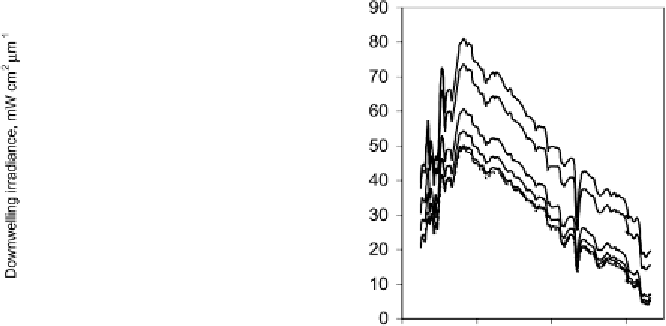Geoscience Reference
In-Depth Information
Fig. 3.13.
The results of the airborne sounding in the overcast sky, experiment 7 in Table 3.2
are demonstrated. Value
f
s
characterizing the variations of solar radiation
absorbed in the system “cloudy atmosphere plus surface” comparing with the
system “clear atmosphere plus surface” is presented in Table 3.2 as well. We
will describe value
f
s
in detail in the following section.
The data of the spectral radiation measurements accomplished on the 20th
April 1985 above the Ladoga Lake and processed in accordance with the
methodology described in Sect. 3.2 are presented in Fig. 3.13 and in Table A.3
of Appendix A (experiment 7 in Table 3.2). The comparison with the data of the
observations carried out on 24 April 1985 in the clear atmosphere (Table A.2
of Appendix A) also above the Ladoga Lake indicate higher values of solar
radiation absorption in the cloud layer. Besides, the values of the downwelling
irradiance at level 1.4 km (
∼
850mbar) of the second observation are lower
than the values of the first one. This might be caused by the extinction of
radiation in thin cirrus clouds or aerosol layers in the upper troposphere and
in the stratosphere.
3.3.2
The Radiation Absorption in the Atmosphere
Now we will pay attention to the estimation of the radiative flux divergence as
a main aim of the radiative observations. To provide the possibility of compar-
ison between the obtained results, the radiative flux divergence is normalized
to the thickness of the atmospheric layer and then it computes according to
(1.8).
The magnitude of the radiative flux divergence in the shortwave spectral
region is close to zero and its uncertainty is rather high. The magnitude of























































Search WWH ::

Custom Search